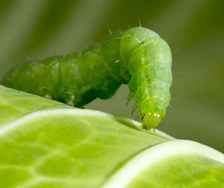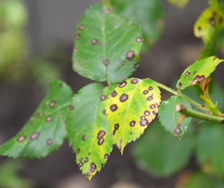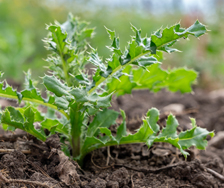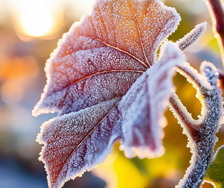Yates Account
Join now
Create a Yates account today!
Sign up to join the Yates Garden Club for monthly e-mails packed with seasonal inspiration, tips for success & exclusive promotions.
Plus if you’re a Garden Club member you can take part in the Yates Growing Community - a blog to share successes, get advice & win prizes in fun challenges along the way!

Forgot password
Enter the email address associated with your account, and we'll email you a new password.

The art of plant propagation covers many different techniques, like growing seeds, dividing clumps of plants, striking cuttings, or tissue culture. It also includes less well-known procedures which deserve more attention, because they're so simple to do. So, it's time to shine a spotlight on layering.
If you haven't tried it before, here's how to create free new plants, using this very easy method.
‘Layering’ is a method of vegetative plant propagation, where new stems remain attached to the parent plant while they develop their own roots. Unlike snipping stem cuttings off a plant, with layering, the layered stems still have access to some moisture and nutrients from the parent plant. This helps make the transition to become a separate plant less stressful.
Layering is a very traditional technique; it gets an early written mention in Fitzherbert's Boke of Husbandrye, which was published in 1523. That’s so long ago, Henry VIII was on the English throne (and hadn’t yet dumped his first wife).
Layering may sound technical, but it’s quite easy to do and enables you to grow more of your favourite plants for free.
This article looks at two forms of layering – layering and air layering.
Layering
Some plants can develop special roots, called ‘adventitious roots’ on their stems or branches, which help them to seek extra moisture and nutrients. These roots also allow them to attach to various vertical surfaces, or grow out into the surrounding soil. Monstera is a great example of how stems can produce these types of above-ground roots. Layering works with plants that already have (or can be encouraged to develop) adventitious roots.
Layering occurs naturally in some plants, like spider plants (Chlorophytum comosum), strawberries, blackberries, and raspberries, where running stems that touch down on the soil can form their own root systems. You can actively promote this type of root development in suitable indoor plants, shrubs and small trees with layering.

Layering a currant bush - note the stem has been bent down, so the middle section in the soil can form new roots.
Indoor Plants Suitable for Layering
- Monstera (Monstera deliciosa)
- Swiss Cheese Plant (Monstera adansonii)
- Philodendron selloum
- Heartleaf Philodendron (Philodendon scandens)
- Chain of Hearts (Ceropegia woodii)
- Devil’s Ivy (Epipremnum spp.)
- English Ivy (Hedera helix)
- Mini Monstera (Rhaphidophora tetrasperma)
Trees & Shrubs Suitable for Layering

Layering a strawberry - the running stem has been trained into a pot, so it can form new roots.
Layering, Step by Step
- Layering is best done in spring and summer when plants are actively growing.
- For outdoor trees and shrubs, choose a flexible stem that’s close to the ground and is long enough for its middle section to dip down and be slightly buried in the soil.
- For indoor plants, choose a stem that can be positioned or bent so it can touch down in a pot filled with potting mix. Seed raising mix, like Yates Black Magic Seed Raising Mix is ideal, as its fine texture helps create good stem/soil contact.
- Not all your layering attempts will work, so, the more stems you use, the greater the chance of success.
- For plants with thick stems, use a clean razor blade or sharp knife to make a shallow, slanting cut (about 2 cm long) on the underside of the middle section of the stem, where it will touch down into the soil. Don’t cut through any more than one-third of the diameter of the stem. Ideally the cut should be made over a node, which is the bump on the stem where leaves would normally grow from. Remove any leaves from around the cut area.
- Cutting the stem triggers a wound response that helps adventitious roots to form, because auxin (a plant hormone that promotes root development) rushes towards the cut and accumulates around it. Auxin is moved through the plant’s vascular tissue, in phloem (phloem provides the plant’s transport system for nutrients) and vascular cambium (cambium is the layer of cells underneath the bark; it's the main source of growth tissue in plants). The auxin stimulates the plant to form new roots at the cut.
- To promote even better root development, you can dip the cut into Yates Clonex Rooting Hormone Gel. Yates Clonex contains auxin, stabilised in a convenient gel format, to help supercharge the root-forming process.
- For indoor plants with thin stems like chain of hearts or ivy, there’s no need to cut or wound the stem, because these plants naturally form adventitious roots.
- Bend the stem down towards the potting soil and bury the wounded section in the ground. It can often help to hold the stem down in the soil with a brick. For indoor plants, you can bend a paperclip into a U-shape, then press that down and over the stem to secure it into the potting soil.
- If you keep the soil moist, but not wet, roots should develop over the coming months.
- Once a small root system has developed (you can check by gently scraping away some of the soil or potting mix), cut the stem off the parent plant with its newly formed roots intact. Pot it up into a small pot with a good potting mix like Yates Premium Potting Mix. It’s important to keep the potting mix moist while the new plant establishes.

Air Layering
Plants with thick, rigid stems, or stems that can’t reach the ground, are best propagated via air layering. Instead of burying the stem in soil or potting mix, moist sphagnum or coir peat is fastened around the stems, above ground level.
Indoor Plants Suitable for Air-Layering
- Umbrella Tree (Schefflera actinophylla)
- Ficus including Fiddle Leaf Fig (Ficus lyrata) and Weeping Fig (Ficus benjamina)
- Philodendron selloum
- Heartleaf Philodendron (Philodendon scandens)
- Monstera (Monstera deliciosa)
- Dracaena (Dracaena fragrans)
Trees & Shrubs Suitable for Air-Layering
Step by Step Air Layering
- Air-layering is best done in spring and summer when most plants are actively growing.
- Choose a mature stem around 30cm long, that’s at least the thickness of a pencil.
- Using a clean razor blade or sharp knife, make a shallow cut on the stem, a few centimetres long, around 20cm down from the stem tip. Make sure you don’t cut through more than one-third of the diameter of the stem.
- For woody stems, add a shallow circular cut around the stem at the top and bottom of the first vertical cut, so you can peel away the top layer of bark on that small section. This exposes the cambium layer just underneath the bark (this is the layer of cells where roots can develop). Ideally the cut should be made over a node. Remove any leaves from around the cut area.


- As with simple layering, cutting the stem promotes a wound response that helps adventitious roots to form, because auxin accumulates around the cut. To promote even better root development, you can dip the cut into Yates Clonex Rooting Hormone Gel.
- Wrap the cut section of stem in a ball of moist sphagnum moss or well-soaked coir (coconut) peat, wrap a clear plastic bag firmly around it to keep the moss or coir snugly contained, then tightly secure the plastic bag around the stem at top and bottom, using budding/grafting tape or rubber bands.
- It’s important that the moss or peat doesn’t dry out during the rooting process. Roots should develop over the coming months, which you’ll be able to see through the clear plastic. Once the new root system has filled the plastic bag, cut the stem off the parent plant, just below the new root system Pot it up into a small pot with a good potting mix like Yates Premium Potting Mix. Keep the potting mix moist while the new plant establishes itself.
Hygiene
Before starting layering, ensure your tools are sterilised to limit the spread of diseases. Dip tools in bleach solution (1-part bleach to 10 parts water) and re-sterilise them between each plant, to avoid transferring any infections between plants.

















Share
Share this article on social media